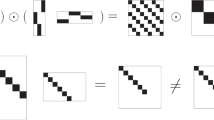Abstract
Ill-posed inverse problems of recovering nonlinear dependencies in observational data are considered. An inductive method is developed for construction of a Bayesian model of support vector regression in Bernstein form. A new Bayesian evidence criterion is used to compare the adequacy of models.
Similar content being viewed by others
References
B. E. Boser, I. M. Guyon, and V. N. Vapnik “A training algorithm for optimal margin classifiers,” in: D. Haussler (ed.), Proc. Annual Conf. on Comput. Learning Theory, ACM Press, Pittsburgh (PA) (1992), 144–152.
V. Vapnik, S. Golowich, and A. Smola, “Support vector method for function approximation, regression estimation, and signal processing,” Advances in Neural Inform. Process. Systems, 9, 281–287, MIT Press, Cambridge (MA) (1997).
A. J. Smola and B. Schölkopf, “A tutorial on support vector regression,” Statist. and Comput, No. 14, 199–222 (2004).
M. H. Law and J. T. Kwok, “Applying the Bayesian evidence framework to ν-support vector regression,” in: Proc. European Conf. on Machine Learning (ECML), Freiburg, Germany (2001), pp. 312–323.
D. Mackay, “A practical Bayesian framework for backprop networks,” Neural Comput., 4, 448–472 (1992).
W. Chu, S. Keerthi, and C. J. Ong, “Bayesian support vector regression using a unified loss function,” IEEE Trans. on Neural Networks, 15, No. 1, 29–44 (2004).
S. R. Gunn and M. Brown, “SUPANOVA — a sparse, transparent modelling approach,” in: Proc. IEEE Intern. Workshop on Neural Networks for Signal Proces., Madison, Wisconsin (1999), pp. 21–30.
X. Hong and C. J. Harris, “Generalized neurofuzzy network modeling algorithms using Bzier-Bernstein polynomial functions and additive decomposition,” IEEE Trans. Neural Networks, 11, No. 4, 889–902 (2000).
D. Mackay, “Bayesian methods for adaptive models,” Ph. D. Dissertation, California Institute of Technology, Pasadena (1992).
M. Kuss and C. E. Rasmussen, “Assessing approximate inference for binary Gaussian process classification,” J. of Machine Learning Res., No. 6, 1679–1704 (2005).
O. Yu. Mytnik, “Local smoothing of an ε-insensitive loss function in a Bayesian model of support vectors,” in: Proc. IVth Intern. Sci. Conf. “Intellectual Analysis of Information,” Kiev (2006), pp. 189–198.
O. Yu. Mytnik and P. I. Bidyuk, “De Casteljau inverse mapping in fuzzy neural models,” System Investigations and Information Technologies, No. 2, 24–34 (2004).
Author information
Authors and Affiliations
Additional information
__________
Translated from Kibernetika i Sistemnyi Analiz, No. 4, pp. 179–188, July–August 2007.
Rights and permissions
About this article
Cite this article
Mytnik, O.Y. Construction of Bayesian support vector regression in the feature space spanned by Bezier-Bernstein polynomial functions. Cybern Syst Anal 43, 613–620 (2007). https://doi.org/10.1007/s10559-007-0087-x
Received:
Issue Date:
DOI: https://doi.org/10.1007/s10559-007-0087-x




